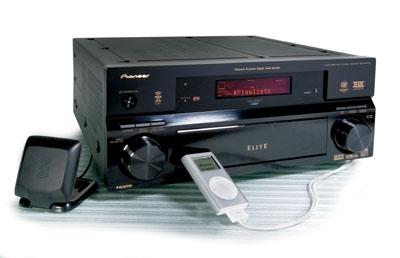Pioneer VSX-74TXVi Digital Surround Receiver

Pioneer sure packed an awful lot of stuff into its new A/V receiver, the Elite VSX-74TXVi, beginning with the mouthful of letters in its model name. Far more engaging is its iPod connectivity: this is the first receiver we've seen to offer fully integrated control for Apple's ubiquitous iPod music player. Then there's its XM satellite radio capability, making it the second XM-ready receiver we've tested after last month's Yamaha RX-V657 (click to see "The List").
| What We Think |
| This receiver's XM-readiness, built-in iPod control, and excellent audio performance help justify a substantial price tag. |
| The Short Form |
| PIONEERELECTRONICS.COM / 800-421-1404 / $1,700 / 16.625 x 7.375 x 18.25 IN / 41.25 LBS |
| Plus |
| •Integrated XM Radio and iPod options. •HDMI source switching. •Good auto setup. •Digital multichannel connection for DVD-Audio/SACD. |
| Minus |
•Densely packed, nonilluminated remote.  |
| Key Features |
| •140 watts x 7 channels •THX Select 2-certified •XM satellite radio expansion via $50 Connect & Play accessory •iPod integration and control •Auto-setup speaker calibration and EQ •Dolby Digital EX, DTS-ES, Dolby Pro Logic IIx, DTS Neo:6, 12 proprietary DSP surround modes including Headphone •Source upconversion to HDMI, component-video, S-video •2 HDMI inputs, 1 output •2 i.Link (FireWire) inputs •3-zone multiroom capability •Back surround speaker outputs reassignable to remote-room use •USB input compatible with MP3 and Windows Media 9 formats •preprogrammed/learning remote •IR-control I/O for remote room |
| Test Bench |
| The Pioneer measured as expected for power output, which led a list of generally excellent bench results. Subwoofer-channel distortion, though measuring high on our 6-channel, 0-dBFS torture test (8.6%), was perfectly fine with any real-world combination of channels/levels. No bass management is provided for analog multichannel inputs, but this will be moot if you use the digital multichannel hookup for DVD-Audio or SACD playback. Click for full lab results |
Unpacking the receiver reveals a small, cone-shaped microphone that's used for automatic speaker setup and speaker/room equalization. And the up-to-the-minute jack pack includes two HDMI inputs and an HDMI output for digital A/V switching via a single cable, with full video upconversion of all sources to the HDMI monitor output as well as the component and S-video outs.
There's also an i.Link (a.k.a. FireWire) connection for multichannel digital output from some Super Audio CD and DVD-Audio players. The THX Select 2-certified receiver has lots more, of course (see "key features" on the right), including the ample seven-channel power that's de riguer at this price and a full range of Dolby and DTS surround options.
SETUP To get XM radio service you need to jack a $50 XM Connect & Play add-on antenna/tuner module - available from Audiovox and (eventually) others - into the Pioneer's back panel. With the antenna plunked on top of the receiver and aimed toward a southwest-facing window, XM came up almost immediately when I selected the XM/Tuner input. Using the onscreen antenna-strength graph, I adjusted the antenna to lock in the best signal. Reception was rock solid.
Connecting an iPod mini was a simple matter of plugging one end of the supplied cable into the mini's dock connector and the other into a jack on the receiver's rear panel. As long as your iPod has a dock port (all but the early ones do), you'll be good to go.
Pioneer's auto-setup routine goes by the awkward acronym MCACC, which stands for Multi-Channel Acoustic Calibration Circuit. When you hit the onscreen Go button, about 5 minutes of noise bursts and clicks cycle through your speakers as the receiver dials in speaker "sizes," levels, distances, and crossover frequencies. There are also a couple types of equalization, including a graphic EQ adjustment for each main channel. (You can repeat the setup process for different listening positions and store the results, along with speaker setup choices, in six different memories.) The Pioneer's self-selected speaker level and distance settings were accurate, closely matching those I'd come up with using my own sound meter.































































